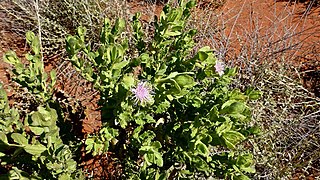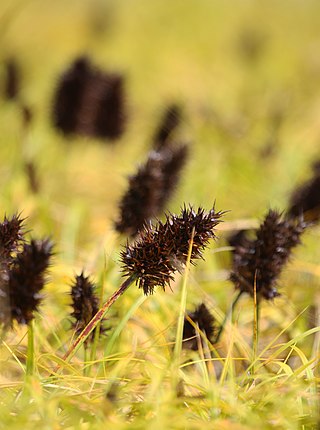
Atractylodes is a genus of Asian flowering plants in the family Asteraceae.

The tomtit is a small passerine bird in the family Petroicidae, the Australasian robins. It is endemic to the islands of New Zealand, ranging across the main islands as well as several of the outlying islands. In the Māori language, the North Island tomtit is known as miromiro and the South Island tomtit is known as ngirungiru. This bird has several other Māori and English names as well. There are several subspecies showing considerable variation in plumage and size. The species is not threatened and has adapted to the changes made to New Zealand's biodiversity.

The big-headed pantanal swamp turtle or pantanal swamp turtle is a species of turtle in the family Chelidae found in Brazil, Bolivia, Argentina, and Paraguay.

Acanthochelys is a genus of turtles, the spiny swamp turtles, in the family Chelidae, subfamily Chelinae, found in South America. Until recently, the species of this genus were considered to be members of the genus Platemys, but were moved to the resurrected genus originally described by Gray (1873) based on the type species by monotypy Acanthochelys spixii.
Hypsopsetta is a genus of righteye flounders native to the Pacific coast of California and the Baja California peninsula, as well as the Gulf of California.

Neobuxbaumia macrocephala is a long-lived columnar cactus
Wulffia is a genus of flowering plants in the sunflower tribe within the daisy family.

The diamond turbot is a flatfish of the family Pleuronectidae. It is a demersal fish that lives in subtropical waters on sand or mud bottoms at depths of up to 50 metres (160 ft), though it is most commonly found between 1 and 20 metres. Its native habitat is the coastal areas of the eastern Pacific, from Cape Mendocino, California in the north to Baja California in Mexico in the south. The turbot is dark green with light blue spots. It reaches up to 46 centimetres (18 in) in length, and its maximum reported lifespan is 9 years.
The Chatham tomtit is a subspecies of tomtit found on some of the smaller islands of New Zealand. It is most similar in plumage to the South Island tomtit, the nominate subspecies. The New Zealand government is implementing a plan to help this species and other bird species recover. The holotype is in the collection of the Museum of New Zealand Te Papa Tongarewa.
Percina macrocephala, also known commonly as the longhead darter, is a species of freshwater ray-finned fish, a darter in the subfamily Etheostomatinae, part of the family Percidae, which also contains the perches, ruffes, and pikeperches. P. macrocephala is endemic to the United States.

Malayemys is a genus of turtles in the family Geoemydidae. It was considered monotypic until 2005 It is found in several countries of Southeast Asia.

Hyperia macrocephala is a species of zooplankton, an amphipod in the family Hyperiidae.

The Malayan snail-eating turtle is a species of turtle in Malayemys genus of the family Geoemydidae.

Centaurea macrocephala is a species of flowering plant in the family Asteraceae, and a member of the thistle tribe, Cardueae (Cynareae). It has many common names, including bighead knapweed, big yellow centaurea, lemon fluff, yellow bachelor's button, yellow hardhat, and Armenian basketflower.
Galinsoga macrocephala is a South American species of flowering plant in the family Asteraceae. It has been found only in Venezuela.
Leiocithara macrocephala is a species of sea snail, a marine gastropod mollusk in the family Mangeliidae.
Caecosagitta macrocephala is a deep sea marine chaetognath that is distributed in meso- and bathypelagic layers. It has a very wide distribution that ranges from the Subantarctic to Subarctic Ocean. Cecosagitta macrocephalas have large heads, hence their name “macro-cephala”. Within their eyes are photoreceptive regions that allow them to catch weak light at bathypelagic depths. Along with their eyes, their gut or intestine has orange pigmentation and a luminous organ that gleams due to bioluminescence unlike some other species of Sagittidae. To be more precise, the luminescent organ is located on the ventral edge of each anterior lateral fin. It is the only member of the genus Caecosagitta, and only one of the two known species of bioluminescent chaetognath, the other being the distantly related Eukrohnia fowleri. C. macrocephala has a secreted bioluminescence that is thought to be coelenterazine based. The luciferase is highly unstable, being unable to survive a single freeze-thaw, and is rapidly inactivated at ice-cold temperatures.

Atractylodes macrocephala is a species of Atractylodes that grows in central China. The roots are consumed as a Chinese herbal medicine.

Streptoglossa macrocephala is a species of flowering plant in the family Asteraceae. It is a spreading or upright perennial herb with pink to purple flowers. It grows in Queensland, Western Australia and the Northern Territory.

Carex macrocephala, the big-head sedge or largehead sedge, is a species of flowering plant in the family Cyperaceae. It is found on the beaches and dunes of the northern Pacific; Japan, Primorsky Krai, Sakhalin, the Kurils and Kamchatka in the Russian Far East, and Alaska, British Columbia, Washington state and Oregon in North America.












